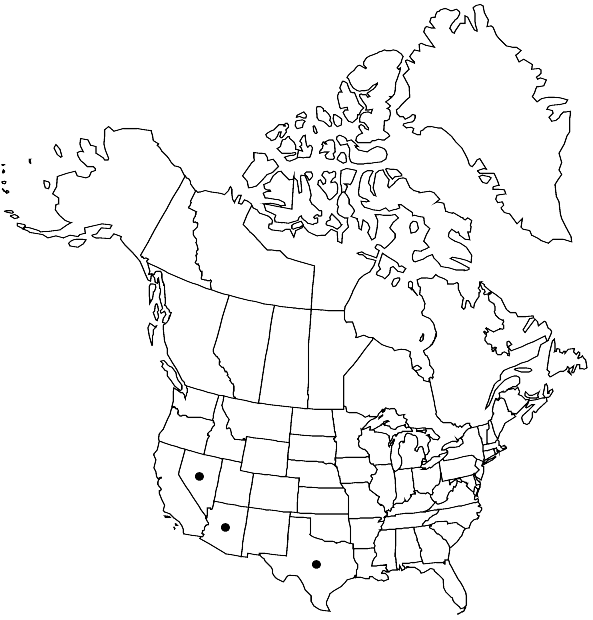Grimmia americana
Bryologist 32: 8, fig. 1. 1929,.
Plants in hoary tufts, dark green to brown. Stems 0.5–1.5 cm. Leaves oblong-ovate to oblong-lanceolate, 1.5–2 × 0.5–0.9 mm, concave, awn to 1 mm; basal juxtacostal laminal cells quadrate to short-rectangular, straight, thick-walled; basal marginal laminal cells quadrate to long-rectangular, straight, thick-walled, medial laminal cells roundedquadrate, slightly thick-walled; distal laminal cells 2-stratose, marginal cells 2-stratose. Sexual condition gonioautoicous. Seta straight to arcuate, 0.6–1 mm. Capsule usually present, exothecial cells thick-walled, annulus of 2–3 rows of rectangular, thin-walled cells, revoluble, operculum rostellate, peristome present, fully developed, perforated and split in most distal part, weakly papillose.
Habitat: Calcareous rock
Elevation: moderate to high elevations (ca. 1600 m)
Distribution

Ariz., Nev., Tex.
Discussion
Of conservation concern.
Grimmia americana is a rare endemic, currently known only from three sites. Until 1999, the species was known only from its type locality in Jeff Davis County of western Texas. A second locality was reported by J. Muñoz (1999) in Arizona and a third site by L. R. Stark et al. (2002) in Nevada. Thus, it is reasonable to expect G. americana to occur also in southern New Mexico. It is recognized as a member of subg. Grimmia by its immersed, ventricose capsule, with a short mitrate calyptra and eccentric seta attachment. The overall habit of the species also is similar to that of the other members of the subgenus. However, its basal laminal cells are thick-walled while other members have thin cell walls. H. A. Crum (1994c) implied that G. americana is similar to G. anodon, but the former is readily separated by its fully developed, perforated peristome, rostellate operculum, and thick-walled basal laminal cells. Grimmia crinitoleucophaea, also most commonly found in the American Southwest, is dioicous, has a rudimentary peristome, and thin-walled basal laminal cells.
Selected References
None.
